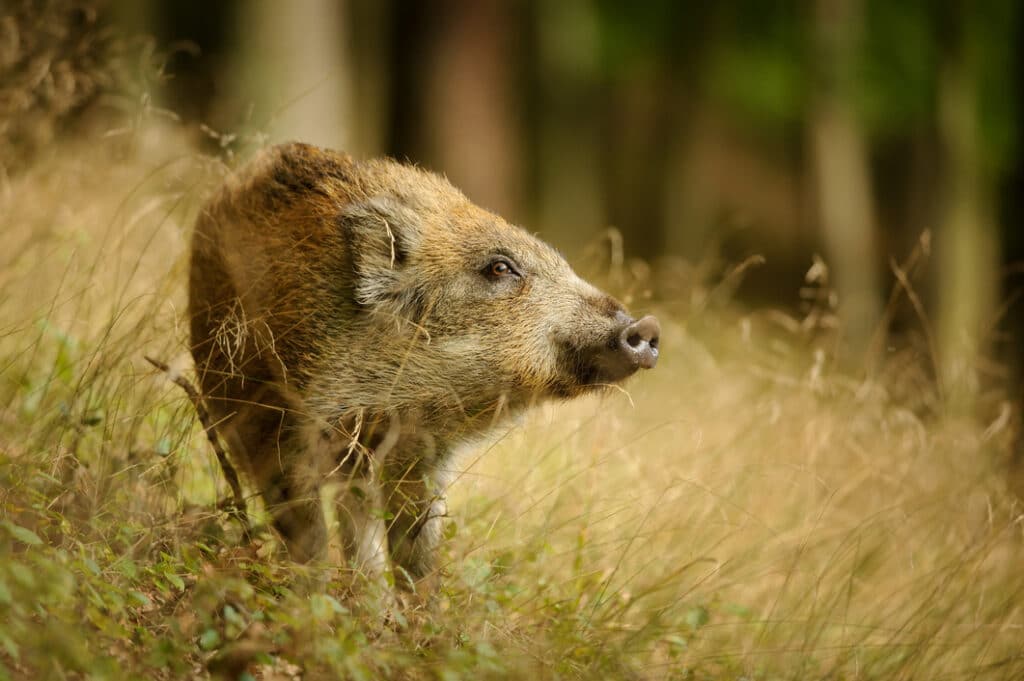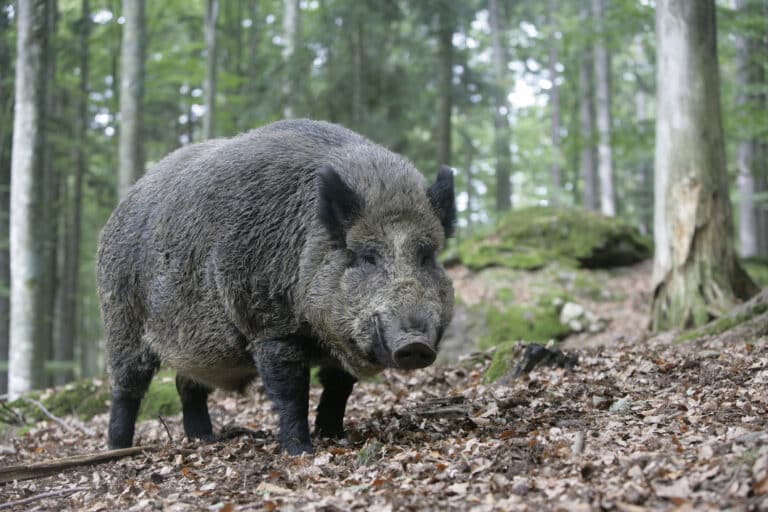Facts about the Wild Boar
Scientific name: Sus scrofa
At a glance
- Ancestor of the domestic pig.
- The wild boar was once widespread here but was wiped out by over-hunting by the 1300s.
- In the 1990s sightings of free-living boar became relatively common again.

The Wild Boar (or Eurasian Wild Pig) is an omnivorous mammal native to much of Eurasia and North Africa.
Pigs were domesticated about 10,000 years ago and wild and domestic pigs belong to the same species The species (or at least feral hybrids) is now one of the widest-ranging mammals in the world, as well as the most widespread ‘pig’.
Boar can live in a wide variety of habitats (as long as three conditions are met:: heavily brushed areas providing shelter from predators, water for drinking and bathing, and an absence of regular snowfall) and populations can increase rapidly. In many parts of its range it causes extensive damage to agriculture and natural habitats, threatens native species, and carries diseases which can affect domestic animals or humans. It’s now considered the most abundant, widespread, and ecologically significant introduced large vertebrate currently found on oceanic islands in the Pacific basin, for example, and was imported from Europe to Australia in 1788 as livestock: in 2021, it was estimated that Queensland alone had up to 2.3 million feral pigs. The species is listed by the IUCN SSC Invasive Species Specialist Group as one of the world’s 100 worst invasive species.
The status of wild boar in the UK is complicated – and contentious. A native species, Wild Boar were once common in wooded country, but declined as agriculture felled and fragmented its woodland home. It finally lost out to over-hunting and control to safeguard crops in the 13th century. But in the 1990s, sightings of free-living boar became relatively common again. These animals are thought to have escaped or been released from farms where they were raised for meat.
Boars – somewhat like Beavers, another large, potential reintroduction to the larger countryside – spilt opinions.
Many people where boars are beginning to herd and dig in gardens, think they should be culled (they have no natural predators as all of those were wiped out even earlier than we wiped out Wild Boar) and tell local newspapers that boars are ‘dangerous’ (they actually pose little threat to humans as long as they are not unduly disturbed, though during the breeding season any sow with piglets should be given a wide berth). On the other hand, Rewilding UK describes Wild Boar as “the quintessential soil ecosystem engineer” ploughing woodland leaf litter and upturning soil in search of tubers and grubs. They go on to say that, “By breaking up the sward, the seeds of annual wildflowers, shrubs and trees are given space to germinate. Disturbed ground provides warm basking spots for grasshoppers and burrowing opportunities for myriad species of bees and beetles. By exposing buried seeds, boar provide access to food for hungry birds during the leanest months.”

The future of Wild Boar in the UK will probably not be decided by the majority of us. The usual scenario is that the government will consult with shooting and farming interests, and shooting lobbyists BASC has already declared that a mooted Wild Boar Action Plan “must be decided by those who will be most affected by their presence, i.e. the landowners, farmers, and wildlife managers” (the latter translates as shoot operators). In June 2022, The Daily Telegraph typically stuck its nose in, ‘reporting’ that ‘Scottish farmers’ were accusing “rampaging wild boars weighing more than 30 stone” of attacking lambs and – of course – “must be culled” (which is much what they are reporting saying about White-tailed Eagles and Beavers and will be saying ahead of any future releases of Lynx).
A position statement published by the Mammal Society in 2015 took a notably more reasonable stance, suggesting that they do “not support unlicensed releases. We recommend further research on existing populations to clarify the positive and negative effects they may have. We recommend that any future reintroduction follows IUCN guidelines, includes a risk assessment of potential adverse effects, and includes strategies to mitigate against them.“
The constant clash between those interested in restoring and recovering lost wildlife and those lobbying groups who won’t tolerate anything that they think might impact them no matter how sightly is frustrating and wrong-headed. The majority of the UK want to see a more biologically diverse and ecologically balanced country – certainly far more then they do sterilised, nature depleted fields or 50 million non-native pheasants being produced for the gun every year.
